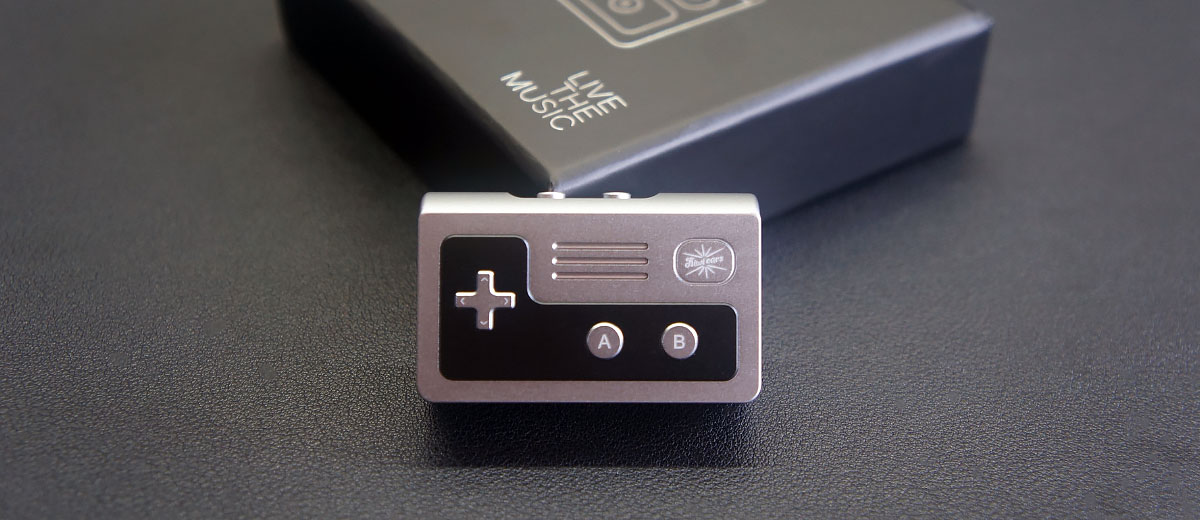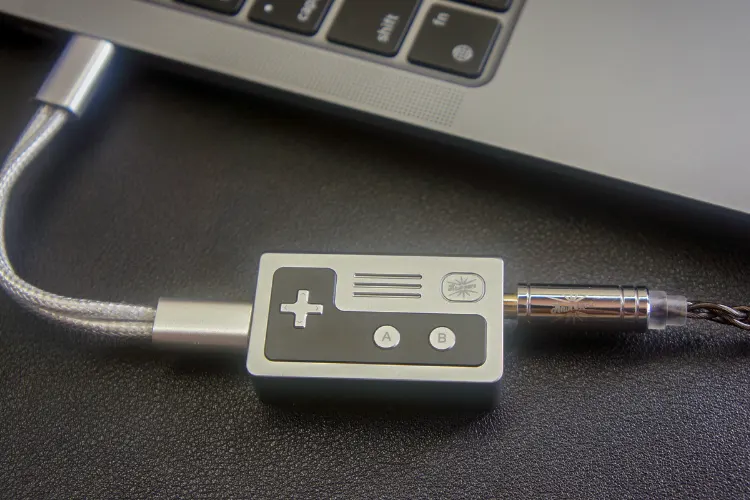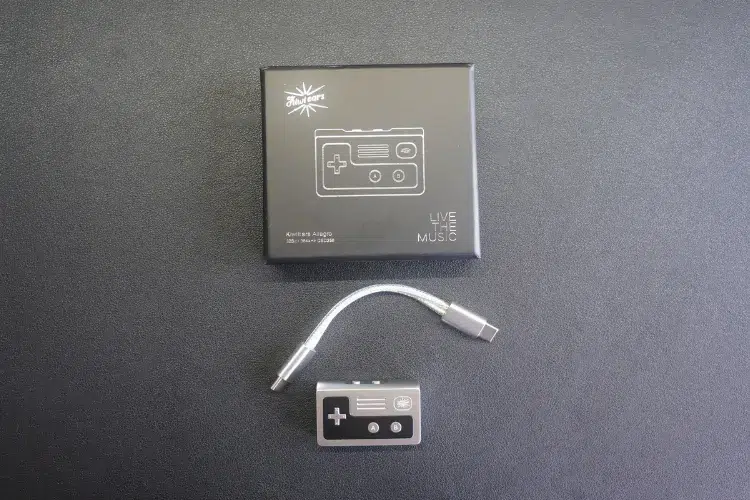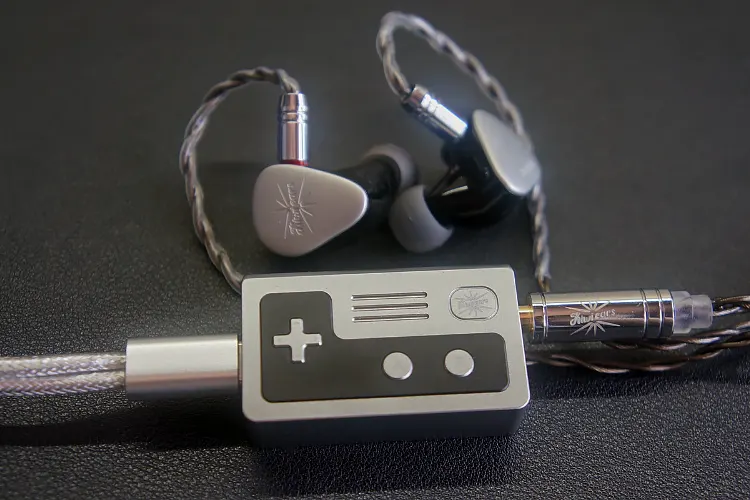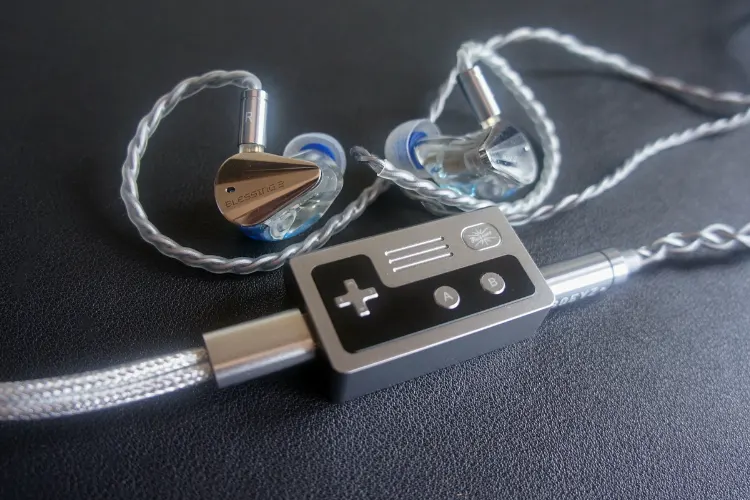In this feature, Meldrick reviews the Kiwi Ears Allegro, which is a retro-gaming-inspired ES9028Q2M dongle DAC with up to 155mW of balanced output power. It is priced at $59.99.
Disclaimer: This is a sample sent in exchange for my honest opinion. Headfonics is an independent website with no affiliate links or services. I thank Linsoul and Kiwi Ears for their support.
Click here to read more about Kiwi Ears gear previously reviewed on Headfonics.
Note, this article follows our latest scoring guidelines which you can read in more detail here.
Over the past 2 years or so, Kiwi Ears has slowly been gaining a foothold in the Chi-Fi space with their competitive IEMs such as the Quartet and Quintet. However, they are now attempting an entry into the competitive dongle DAC market with their new Allegro.
Being the brand’s first venture outside of the IEM space, the $59.99 Allegro dongle could provide a unique house sound compared to other more established Dongle manufacturers.
To see how the newcomer Allegro performs and compares to other dongles in the market, continue reading our review below.
Features
The Kiwi Ears Allegro is a balanced portable dongle DAC equipped with a single ES9028Q2M DAC chipset capable of up to PCM 32BIT/384kHz and DSD256 native decoding.
The Allegro can deliver up to 70mW into a 32Ω load single-ended and a respectable 155mW at 32Ω from its balanced 4.4mm PO output.
Design
The Allegro’s design is its most striking feature. Harking back to console controllers of the 8 and 16-bit era, the Allegro integrates considerably more design flare than most dongles on the market.
The decorative anodized silver aluminum D-pad and A B buttons are non-functional and do not press into the black L-shaped decorative stripe surrounding them.
Above the main cluster of buttons are CNC-machined grooves imitating the onboard speakers of older controllers, as well as an engraved Kiwi Ears logo.
The upper edge of the unit houses the Allegro’s actual functional buttons. The + and – buttons are constructed out of the same aluminum as the decorative buttons, and press down with a dense, satisfying click and sound.
The rightmost surface of the Allegro houses the unit’s 4.4mm BAL and 3.5m SE output, whilst the leftmost edge houses the unit’s USB-C Female input.
The rear of the unit is etched with a larger Kiwi Ears logo, with basic DAC and decoding specifications below. The rear also houses a minuscule LED that shines blue when powered on.
The Allegro’s CNC-Machined aerospace-grade aluminum construction is reassuring. Its anodized finish gives it a hefty feel in the hand while keeping it resistant to fingerprints and micro scratches in everyday use.
The Allegro’s sharp edges could use further improvements, its precision chamfers are not quite to the level of ddHiFi, but this does not detract from the overall very good fit and finish of the unit.
Coming in at 10.47 x 7.72 x 0.87 inches, the Allegro is larger than most attached dongles I’ve tried, but its rectangular shape and flexible USB-C cable still make it easily pocketable.
I/O
The Allegro’s sole input is a female USB-C jack to pair with an included 12.5mm USB-C to USB-C cable. With a 3.5mm SE and 4.4mm balanced sockets, Allegro’s output options are above average for this price point.
The unit’s connectivity options make it a good “one-size-fits-all” beginner dongle that leaves enough room to maintain compatibility with larger collections and pricier upgrades.
Controls
Unlike most dongles I’ve tried, The Allegro incorporates physical volume up and volume down buttons. This was initially a welcome surprise as it would have made volume control more convenient.
However, on all the sources I’ve tried (Windows laptops, MacBooks, iPhones, and USB-C Android Phones) Allegro’s physical volume control did not control the software volume control of the source device.
This means that the Allegro’s volume control and the source device’s volume control are completely independent from one another.
This is not inherently a bad thing, I’ve tested multiple desktop amplifiers that do the same thing, the main issue presents itself when you take into consideration the Allegro’s lack of a screen, knob, or any indication of the current volume level.
Because of this, I never had any indication if I was already reaching the full power output of the dongle.
Further adding to this problem is how little the volume increases and decreases when pressing the volume up and down buttons, I found my pressing the volume buttons significantly more than I am accustomed to from my experience with smartphone volume controls.
Packaging & Accessories
Opening the box lid shows the foam insert containing the Allegro dongle the included detachable USB-C Cable, and a simple instruction manual.
The inclusions stick to the bare minimum needed for a plug-and-play experience, but this is sufficient for a dongle DAC at a sub-$60 price point.
Sound Impressions
All testing and comparisons were done through 3 pairs of IEMS, namely the Moondrop Blessing 3, the Kiwi Ears Quintet, and my new go-to planar magnetic IEM, the Shozy P20 as well as the Sennheiser HD580 Precision
Summary
The Kiwi Ears Allegro presents a unique sound profile, combining warmth in the mid-bass with occasional sibilance and metallic tones in the lower treble.
Its emphasis on sub-bass adds depth to background elements while delivering textured kick drums and satisfying bass lines.
This signature lends itself well to laid-back genres like indie rock and ballads, though some fidelity and resolution are sacrificed in the mid-range.
Staging and dynamics are solid, with a respectable sound stage and good dynamics, especially in the bass, although imaging can falter in busier arrangements.
Timbre
The Allegro adds a slight emphasis on the sub-bass, giving background hums and rumbles a more atmospheric and moody feel.
The Allegro, however, does show the full degree of its warmth in the mid-bass region, wherein hits from kick drums are played back with good texture and detail, and strums from funk bass lines are delivered with satisfying note weight.
This contributes to a more laid-back sound signature in simple indie rock and balladic tracks with female vocals. The Allegro’s low-end warmth carries over into the mid-range by smoothening out string instruments, albeit at the cost of some fidelity and resolution.
Male vocals, in particular, are given a velvety smooth sense of authority, enveloping the whole sound. Female vocals are not given the same level of presence but are still played back with sufficient detail and texture.
Treble performance is a mixed back with the Allegro. Instruments on the upper range of the treble region such as hi-hat and crash cymbals inherit the smooth tonality from the unit’s warm sound signature. However, I experienced some sharpness and sibilance specifically in the snare drum region.
The Allegro’s presentation of snares and higher frequency percussive instruments have a metallic piercing tonality that makes them stand out from the otherwise relaxing sound signature of the dongle.
For certain genres such as indie rock and acoustic pop, I rarely heard percussion sharpness. However, in more complex modern Pop, Hip-Hop, and Alternative tracks, the snare drum sharpness caused some listening fatigue.
Staging & Dynamics
The unit has a decent sound stage, it never impresses with a holographic 360-degree sound stage, but it never invokes a sense of too much intimacy or claustrophobia.
It has a respectable horizontal staging quality and does not limit or restrict the staging performance of any of the IEMs I’ve tried with it.
The Allegro has decent to sub-par imaging depending on the track. In more simple tracks with fewer elements within the mix, the individual instruments are decently separated. However, their exact pin-point location is not translated very well due to the warm sound signatures smoothening of microdetail.
In busier tracks, the imaging performance can be quite sub-par. In complex Hip-Hop and Electronic arrangements, sounds of similar frequencies tended to mesh together and playback as a vague wall of sound.
Its dynamics are quite good. Especially in the bass region, rumble and kick drum hits are presented with good note weight and authority, contributing to a relaxing sound signature that encapsulates the listener.
Synergy
Power
The Kiwi Ears Allegro boasts a rated power output of 155mW into 32Ω and 70mW into 32Ω via its 4.4mm balanced output and 3.5 SE respectively.
Even for planar magnetic IEMs such as the Shozy P20, I found that the SE output was more than enough to power and fully maximize the sonic capabilities of the IEMs. I also found that Allegro’s SE performance was sufficient in maximizing Quintet’s performance.
For more demanding IEMs such as my Moondrop Blessing 3, I noticed improved instrument separation and imaging when going from the single-ended output to the Balanced output.
To reduce the number of variables, I used the BQEZY Winter Ultra cable and its detachable 3.5mm/4,4mm terminations to switch between the Allegro’s two outputs.
It does come close to driving harder-to-handle full-sized headphones such as my HD 580 Precision. It was able to drive these to a comfortable listening level without maxing out the volume output.
However, I did notice that instruments in the treble region started showing a distorted metallic tonality that made listening to them quite fatiguing. Additionally, the overall imaging and separation performance was decreased when compared to driving the HD 580 through a desktop amplifier.
Its quiet background also makes it ideal for sensitive IEMs. In my experience, instances of hissing when connecting IEMs to the 4.4mm outputs of DAC/AMPs like the VE Megatron were not observed with the Kiwi Ears Allegro
Pairings
I found that the Allegro paired best with IEMs with a scoop in the lower treble region, this compensated for the strangle metallic fatigue I observed with the Allegro.
Among all the headphones and IEMs I tried, I thoroughly enjoyed pairing the Allegro with the Shozy P20 the most.
With its V-shaped sound signature, the snare regions of the P20 always had a decent sense of resolution despite being drowned out in the mix at times. The Allegro managed to bring that portion of the frequency response forward while maintaining a pleasing tonality.
The already strong bass response of the P20 was given additional warmth and body, but this did not bleed into the mids at all. It merely gave the P20 a thicker sound signature that I found to be more relaxing for casual listening.
I did not find myself enjoying the pairing of the Allegro with the Blessing 3 or the Kiwi Ears Quintet. The neutral tonality of the Blessing 3 did not compliment the Allegro’s peaks in the lower treble region.
This pairing was still resolving and well-textured, but the fatiguing issues I experienced prevented me from enjoying the combination for an extended period.
The Quintet’s more energetic treble region did not pair well with the tonality of the Allegro, the peaks in the treble region caused by the dongle had a similarly fatiguing effect that I did not find too enjoyable.
In a pinch, I could see myself driving the HD580 precision with the Kiwi Ears Allegro. However, it is unable to replicate the same treble response, imaging, and instrument separation when driven by a more capable desktop unit such as the FiiO K11.

